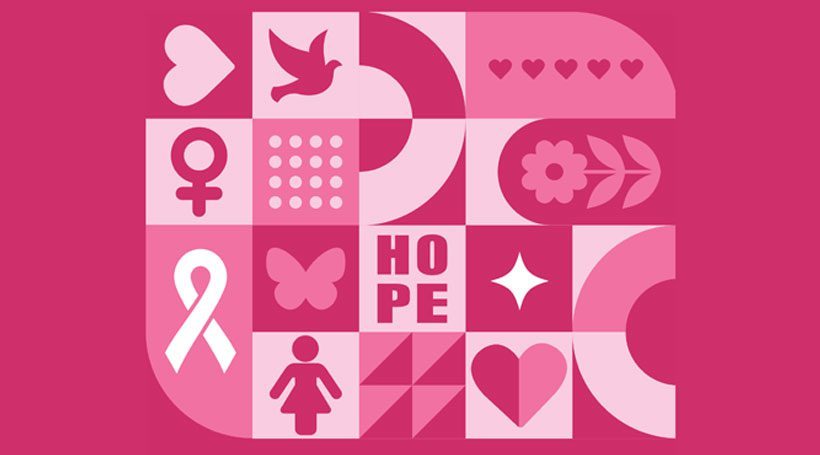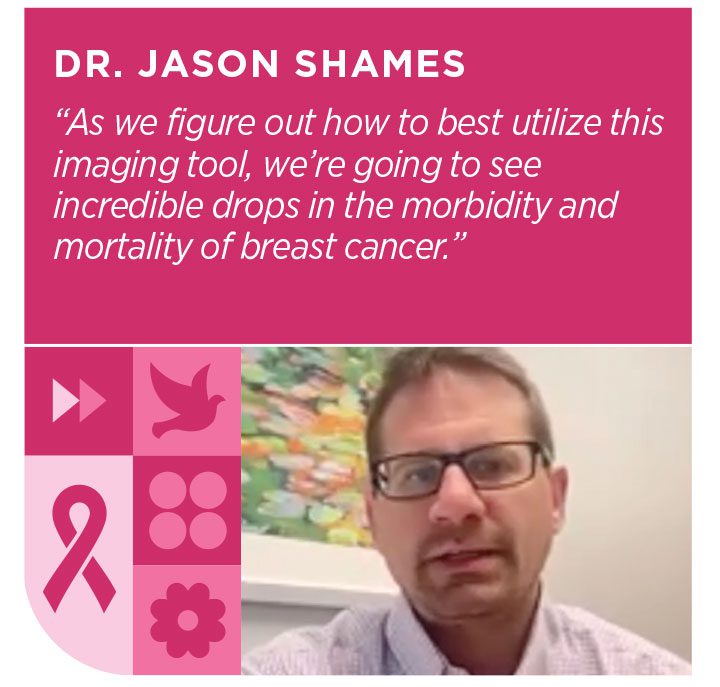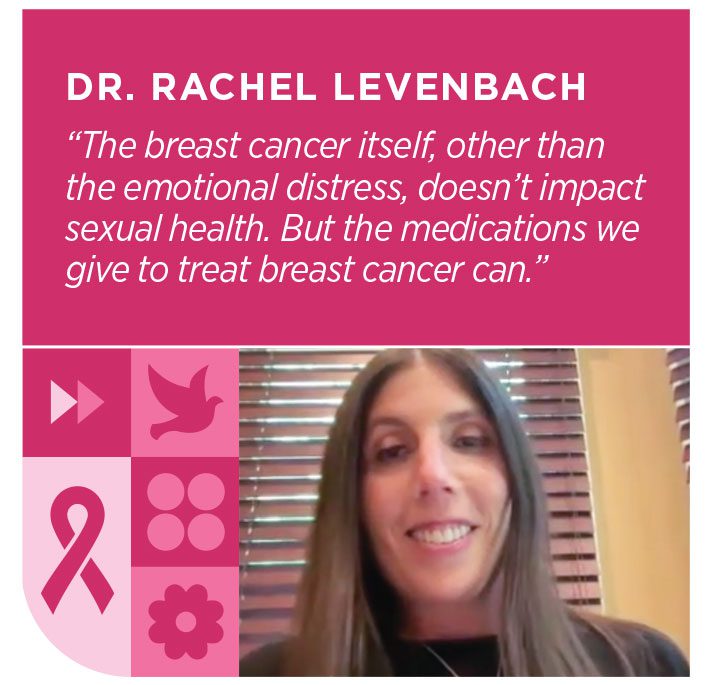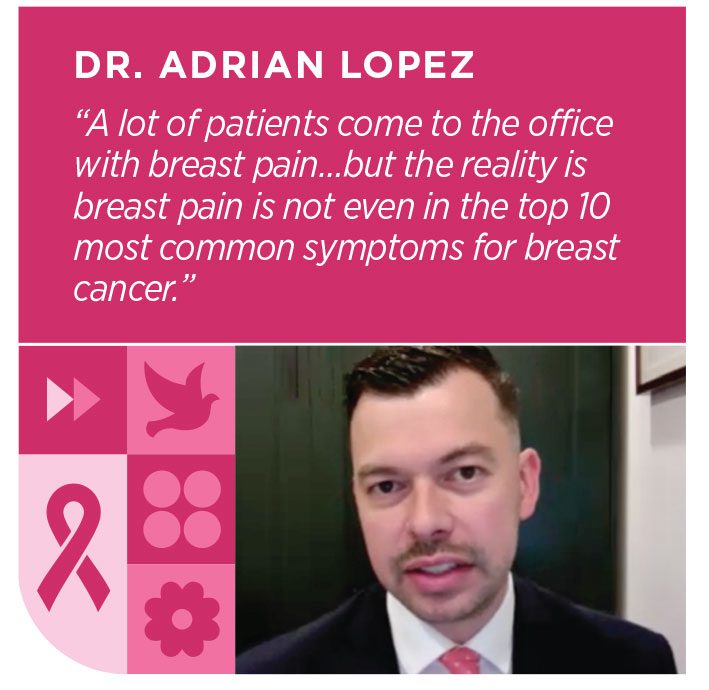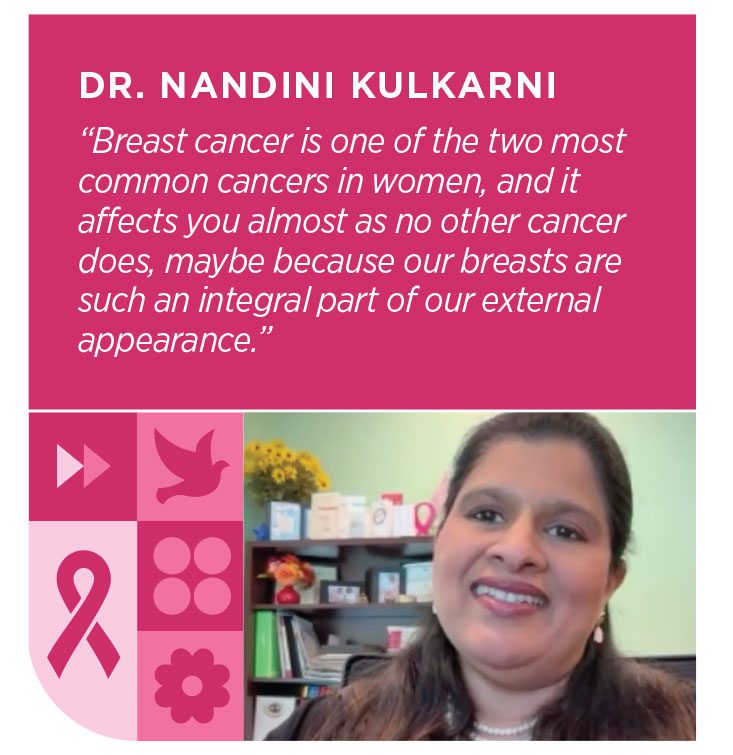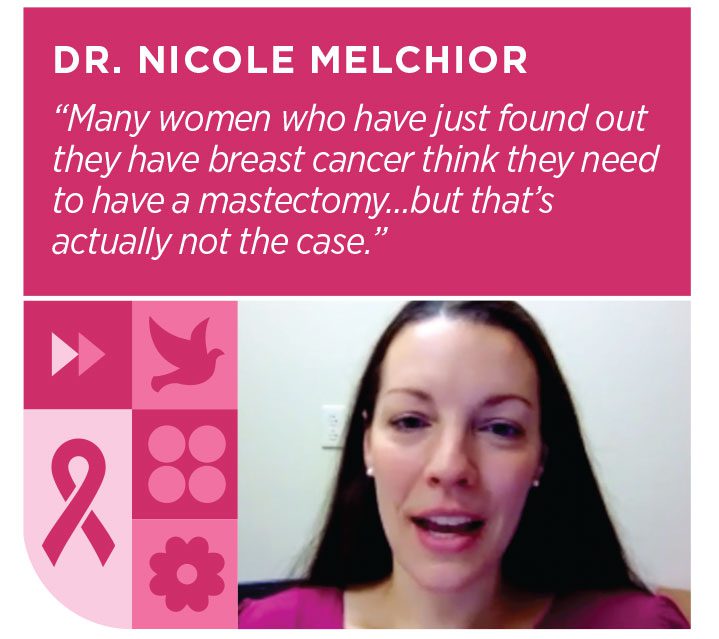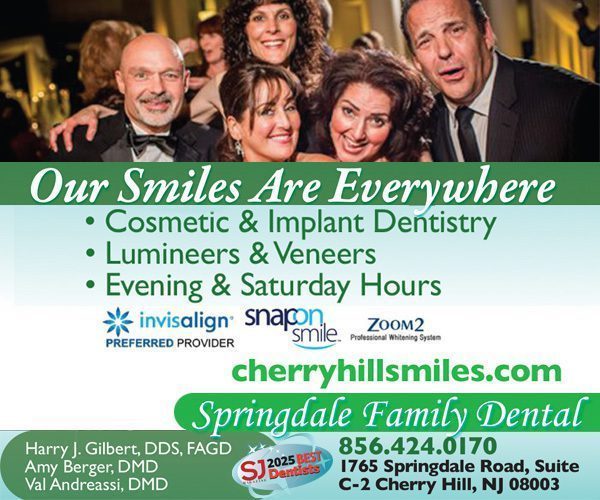As the years go on, researchers discover more and more about breast cancer screenings and treatment, and this leads to better outcomes, as well as better quality of life, for patients. We talked with South Jersey’s breast cancer specialists to find out what we all should know about the disease – what’s new, what’s the same, and why it all matters.
Participants:
Nikki Ariaratnam, MD Breast Imaging Specialist, South Jersey Radiology
Adrian Lopez, MD Breast Surgeon, MD Anderson Cancer Center at Cooper
Erica Linden, MD Medical Director, Breast Oncology and Cancer Genetics, Capital Health
Rachel Levenbach, MD Oncologist, Regional Cancer Care Associates
Nandini Kulkarni, MD Medical Director, Surgical Oncology, Inspira Health
Nicole Melchior, DO Breast Surgeon, Penn Medicine | Virtua Health Cancer Program
Morgan Callahan, DO Microvascular Plastic Surgeon, Penn Medicine | Virtua Health Cancer Program
Jason Shames, MD Interim Director, Division of Breast Imaging Jefferson Health
Rachel Berger, MD Breast Surgeon, Sidney Kimmel Comprehensive Cancer Center – Jefferson Health
Prevalence of breast cancer
Risk is higher than people might think – the risk is just having breasts and aging.
Rachel Berger
One in eight women is diagnosed with breast cancer, so a lot of people know someone who has been diagnosed.
Nicole Melchior
We have such incredible things to help prevent that negative outcome. By having that good awareness, we can help give patients and families a great story that we can’t necessarily do with some of the other diseases.
Jason Shames
Breast cancer is one of the two most common cancers in women, and it affects you almost as no other cancer does, maybe because our breasts are such an integral part of our external appearance.
Nandini Kulkarni
Breast cancer affects around 300,000 women every year in the U.S. Just to give you a comparison, prostate cancer is the most common cancer in men, and it affects around 100,000 men. That’s why everybody – medical and non-medical – pays attention to breast cancer.
Adrian Lopez
Symptoms of breast cancer
For many breast cancers, you are not going to have any symptoms. But when you do, the most common are obviously a lump in the breast, discomfort in the breast, discharge from the nipple, or just changes in the architecture of the breast, so maybe dimpling of the skin or redness of the skin.
Rachel Levenbach
I tell my patients who have a history of breast cancer to look out for anything that’s out of the ordinary. If somebody has headaches and didn’t have headaches before, that’s a change. If somebody has a progressive pain for over two to four weeks, that’s something I want to hear about. Of course, if you feel anything in the breast, under the arm or in the upper neck, I want to know about that.
Erica Linden
The biggest red flag and something that should trigger a patient to consult their physicians is if they feel a lump they have not felt before in their breast. A lot of patients come to the office with breast pain, and they’re very concerned about breast cancer. But the reality is breast pain is not even in the top 10 most common symptoms for breast cancer.
Adrian Lopez
Most breast cancer is diagnosed when someone goes in for their regular screening mammogram and they’re not having symptoms. So people should continue to go for those screenings, even if they aren’t having a problem.
Nicole Melchior
Cancer is cells within the body that are not behaving like the other cells. They’re growing and taking, and growing and growing and growing. If cancer is there, you shouldn’t feel a lump that comes and goes, it will constantly keep progressing and getting bigger. It’s really common for patients to have lumps that have some sort of cycle, and most times, those are benign. But when you’re seeing a lump continue to progress from cycle to cycle, that is an alarming sign that you should see your provider.
Jason Shames
Unfortunately, the symptoms only start once the breast cancer has reached a certain volume. The most common, of course, is being able to palpate a lump. Other things that may go unnoticed is nipple discharge, especially if it’s coming from just one side and if it is either clear or bloody. If the cancer progresses, it can cause skin changes. You might see a rash, or what looks like a rash, on your breast.
Nandini Kulkarni
Are self-exams necessary
It’s important for patients to know their own general baseline lumpiness, so they are able to have an idea if there’s a change. If they are anxious and they do feel a change, we’re always happy to see them, examine them and get imaging ordered if it’s appropriate.
Rachel Berger
There are certain women who we really encourage to do routine self breast exams, and those would be high risk women or men who either harbor mutations for BRCA1 or BRCA2 who have been found to be high risk using other models.
Erica Linden
I always tell women they don’t have to do a self breast exam every night, but know your body. If your breast feels unusual, then examine your breast in the shower, and then bring it to someone’s attention. It’s important to be aware of your body.
Rachel Levenbach
A lot of the cancer societies have been steering away from the self breast exam, and that comes from basically a lot of women doing self breast exams, not finding any abnormalities, and thinking, “You know what? I’m going to skip my mammogram because I don’t feel anything.” We know that screening mammograms can detect breast cancer before you can feel anything in your breast, and that’s when we want to find breast cancer.
Adrian Lopez
I use the term “breast awareness,” but I do encourage women, if they feel comfortable, to try to do intermittent exams, so they get familiar with their breasts and they have an idea of what’s normal. But a lot of younger women, especially if they have very dense tissue, can always feel lumps. And for some people, that causes a lot of anxiety, so it may not be the best thing for everyone.
Nicole Melchior
If you look at the scientific literature, it has clearly shown that breast self-exams are of no value when it comes to detecting breast cancers early. But they are still of some value. We still have a population that is afraid of getting mammograms or is afraid of the diagnosis, so the only way they find out is when they are examining themselves. But if you get your mammogram every year and don’t do a self-exam, you will still be in better shape than just doing the breast self-exam.
Nandini Kulkarni
The self breast exam is virtually the only type of exam that we can do for ourselves, free and anytime. Only you know what your breast texture feels like, and only you can detect changes from month to month and during different times of your menstrual cycle. I always advocate for patients to feel around and see what they can find. If they notice a new lump, and particularly if it’s hard and it’s difficult to move, you should bring that to the attention of your doctor.
Nikki Ariaratnam
It’s always important when you’re doing a self-exam to be consistent at the time of the month when you’re doing it, because there are natural changes that happen during your cycle. If you do feel a change in the breast tissue, don’t keep it secret. Make sure you’re recognizing those changes and letting your provider know so they can look into additional imaging that might be outside of your normal screening time.
Jason Shames
Breast cancer prevention
Unfortunately there’s no silver bullet to prevent breast cancer, but there are ways to help reduce your risk. A healthy lifestyle is key: a healthy diet, exercise, smoking cessation, limiting alcohol intake and routine screenings. Those are the best ways to give you the best outcomes.
Jason Shames
For someone who is at very high risk for breast cancer, because of genetic risk or an actual genetic mutation like the BRCA gene, we do a prophylactic mastectomy and then a reconstruction. They’re not losing their breast for no reason. They’re doing it prophylactically to prevent a cancer in the future, if they’re extremely high risk.
Morgan Callahan
There are ways we can help to reduce the risk of breast cancer, but I don’t think I can say it can be completely prevented. But, have a healthy lifestyle. Eat a diet that is more prominent in fruits and vegetables. And exercise – five days of 30 minutes of exercise a week. And the safe amount of alcohol for women is anywhere from three to five drinks a week.
Nandini Kulkarni
You can mitigate your risk. Some of the risk factors, such as obesity or excessive weight gain, can increase your risk of breast cancer. Smoking has been shown to have a light association. Hormone replacement therapy, although it has good beneficial effects during perimenopause, can sometimes have the hormones that contribute to the growth of breast cancer – though it’s not definitely a causal relationship. Three quarters of breast cancers happen to people who do not have any kind of family history. It happens out of the blue.
Nikki Ariaratnam
It’s impossible to bring down your risk to zero, but you can definitely decrease the risk of breast cancer. Studies have proven that obesity is a risk factor for breast cancer. Smoking is a risk factor for breast cancer. Frequent alcohol intake is a risk factor for breast cancer. If you change those things, you will reduce your risk of breast cancer.
Adrian Lopez
I wouldn’t say you can prevent breast cancer from occurring, but you can pick it up early. A lot of times, women with high-risk diseases are screened with breast MRIs which can pick up lesions that are very tiny, even pre-invasive breast cancers. In that case, yes, we can sometimes prevent them from developing breast cancers.
Rachel Levenbach
What you should know about breast cancer
The most important thing to know is the reason we are so focused on screening and finding breast cancer early is because the majority of breast cancer, if not all, is very treatable and very curable when found early.
Rachel Levenbach
Many women who have just found out they have breast cancer think they need to have a mastectomy, because that’s the best treatment. But that’s actually not the case. There are other options. A lot of women don’t realize that a lumpectomy followed by radiation is equal treatment to a mastectomy.
Nicole Melchior
Patients should know the right time to start screening mammography. There’s been a lot of mixed messaging over the past decade. The greater number of patients should start their annual screening mammograms at age 40. There are some exceptions for patients who have a strong family history. If they have a sister, a mother or first-degree relative with breast cancer, they should start 10 years before that relative was diagnosed.
Nikki Ariaratnam
A woman with breast cancer has options and she has control over her treatment options and reconstructive options. Some patients don’t opt to have reconstruction, and that is an option too. When a patient has a mastectomy, there are a lot of options to personalize their care and do the treatment that’s right for them.
Morgan Callahan
Breast cancer has a great prognosis, particularly when it’s diagnosed early. Stage 0 has a 99% survival rate at 10 years. Stage 1 has over 95% and even a Stage 2 has over 85% survival at 10 years. Patients should be aware that if you get a diagnosis of breast cancer, chances are this is going to be curable.
Adrian Lopez
When I see a patient with early breast cancer, one of the first things I like to tell them is that this is treatable and curable, because people go down a road of thinking this is a death sentence, and it’s not.
Rachel Berger
Many people think breast cancer is one disease. It’s many diseases that have different drivers and different treatments. We think of breast cancer as being at least three, if not four, diseases: Hormone driven, HER2, Triple negative and HER2-low. For these diseases, the drugs are different. The treatment is different. And patterns of relapse are different.
Erica Linden
Myth about breast cancer
A myth I can dispel is that screening mammograms can cause breast cancer. When we do screening mammograms, we do use a tiny dose of radiation because it is an X-ray of sorts, but it’s really a trivial amount. You get much more radiation flying in an airplane. The amount of radiation from screening mammography has no causal relationship with breast cancers. Mammography finds breast cancers, and hopefully when they’re small and treatable.
Nikki Ariaratnam
Patients who come in with a diagnosis of breast cancer, even super early breast cancer, sometimes think they have to remove the other breast. They are worried the breast cancer is going to jump from one breast to the other. That’s a myth. Patients who have a diagnosis of breast cancer generally have a risk of 5% of developing breast cancer in the other side over the next 10 years.
Adrian Lopez
I have patients who have read that underwire bras can cause breast cancer. That’s not true. It’s ok to wear that if you want.
Nicole Melchior
People come in with a new diagnosis of breast cancer and say, “But no one in my family had breast cancer.” It’s a myth that you only get breast cancer if you have a family history. Most patients have no reason for getting breast cancer. It’s just a very common disease. It’s an accident of DNA that results in cancer.
Erica Linden
I’ve heard people say deodorant causes breast cancer. We have no evidence of that. Deodorant is not going to cause breast cancer.
Morgan Callahan
It’s a myth that young women can’t get breast cancer. That’s a dangerous myth, because unfortunately, there is an increase in breast cancer in younger women, and that’s a population that’s not necessarily being screened. I would say if a young woman feels something or notices a change, that should be looked into. We don’t ignore things in very young women.
Rachel Berger
Women with breast cancer sometimes believe if they have both their breasts removed, there’s no chance the breast cancer can come back. I like patients to be aware that even if they have bilateral mastectomies or have both their breasts removed, they will still need treatment to prevent a recurrence. Breast cancer can come back to places outside the breast tissue.
Rachel Levenbach
An advancement in their field
Breast cancer care is becoming more and more personalized. It used to be that everyone got the same treatment, and now that’s not the case. There are parts of treatment that can be omitted or included depending on the individual’s exact situation. That’s a really exciting advancement. We’re getting closer to figuring out what the right treatment is for every individual patient.
Rachel Berger
One exciting advancement is the use of tumor DNA assessment in the blood. Basically, patients who were treated for breast cancer get a blood test, and they are checked for tumor DNA in the blood. Studies have shown that when you detect this tumor DNA, those patients have a higher risk of recurrence. We don’t know yet what to do when we detect it, but it’s very interesting. Maybe in the future patients who have tumor DNA detected in their blood may be treated with something to prevent cancer from coming back.
Adrian Lopez
One of my specialties and the specialties of my partners in this practice is that we do microsurgery. That is a breast reconstruction technique that uses the patient’s own tissue, which is transplanted to the breast for reconstructive purposes.
Morgan Callahan
There’s a lot of excitement about something called antibody-drug conjugates. These are looking at how, instead of wielding, say, a sledgehammer, how can we try to be more precise about how we deliver medications, especially chemotherapy? We’re looking for a marker that distinguishes your cancer cells from normal cells, so we can deliver the medication to only the bad cells, not the good cells. That is a more effective treatment, and it limits the degree of side effects.
Erica Linden
One of the new tools we’re still integrating into the screening world is contrast-enhanced mammography, which will really elevate what we can do in the accuracy of detection of breast cancer and ultimately staging for patients. What’s incredible is that it’s a software update that can happen to normal mammography equipment. As we figure out how to best utilize this imaging tool, we’re going to see incredible drops in the morbidity and mortality of breast cancer.
Jason Shames
The one that really has made the biggest change in the last few years is the de-escalation of axillary surgery for breast cancer. Back in the day, the understanding was that breast cancer was a regional disease, so when it spread, it spread to the regional lymph nodes. All the surgeries then were devised to remove the breast and the lymph nodes. As our understanding of breast cancer improved, we know now that it is more a systemic disease. We found that removing all the lymph nodes under the armpit is not the solution to a better outcome.
Nandini Kulkarni
I would say the biggest advancement is immunotherapy, which looks at the cancer in a different way. These drugs are infused into the body. And the nice part is, they’re very well tolerated. It’s an infusion that circulates throughout the body, finds cancer cells and starts fighting them.
Rachel Levenbach
Emotional toll of breast cancer
Just the simple act of coming in for screening can be very anxiety inducing. I think it’s partially from wondering if this is going to be the time they get that diagnosis. I tell patients, regardless of what we see, knowledge is power. And if we do see something that doesn’t mean it’s cancer. But if we do end up catching the cancer, that’s great news too, because now we found it and we can address it.
Jason Shames
Things affect people in different ways. Families should always assume that cancer is a very serious diagnosis and try to offer the biggest support. I love when family members come to the office. They ask questions that sometimes the patients don’t think about.
Adrian Lopez
How can friends and family help? Just by being there. I encourage my patients to bring their family members to appointments. If they can’t be here, we are more than willing to FaceTime or put them on speaker phone. All patients need is the understanding that you will be there for them.
Nandini Kulkarni
It’s earth shattering when a patient first hears the diagnosis. They may feel some despair and some hopelessness. But we hope to provide advancements, planning and support so patients and their families know there’s a very, very good chance they will survive and thrive after their breast cancer diagnosis.
Nikki Ariaratnam
Hearing the word cancer definitely causes emotional distress. Very often, after a woman sees me and they have a plan in place, they feel better. Once they know the majority of breast cancers are very treatable and very curable, they feel better.
Rachel Levenbach
For younger patients in their 20s and 30s, they’re having to make major life decisions about whether to remove their breasts for the rest of their life or make decisions about fertility, with or without a partner. Or they may be trying to figure out how to raise young children when they have a cancer diagnosis. The good news is most people will get through this and will live long and healthy lives. They will live with breast cancer rather than die from it.
Erica Linden
There’s a lot of information that comes with a breast cancer diagnosis, and patients can be very quickly overwhelmed. They are seeing many doctors – they don’t always hear 100% of what we’re saying. Luckily, we have a nurse navigator who can help them organize appointments and information.
Morgan Callahan
The diagnosis impacts patients because it is so wrapped up in their body image, in their sexuality, in their emotional state and in their relationships. Women tend to be caregivers, so it’s hard for them to ask for help. It is really important to lean on your support systems, because you cannot pour from an empty cup.
Rachel Berger
Disparities in screening & care
I’m a Hispanic doctor, and I get a lot of Hispanic patients in my office. They’re generally from a lower socio-economic status, which is something that our African American patients also have in common. That usually translates to patients not getting care at the right time, prolonging seeing the physician, not getting mammograms or not getting imaging studies, because they don’t have a way to pay or they don’t have the education to know the importance of screening early. At Cooper, we have a fantastic outreach program that tries to help patients from all backgrounds, but we pay a lot of attention to minorities, and we offer charity care for patients who are uninsured or underinsured.
Adrian Lopez
One of the things we have at Virtua is the NJCEED program, which allows women who are uninsured or underinsured to get a screening mammogram. We also have the mobile mammography van, which allows women to get that mammogram they may otherwise not have.
Nicole Melchior
At Jefferson, unfortunately, this area has a higher mortality rate than the national average. We know that non-Hispanic Black woman have an almost 39% higher mortality rate when they’re diagnosed with breast cancer. So we understand how critical it is to make sure we’re breaking down those barriers. With mobile mammography and with education, we’re able to help support them.
Jason Shames
We pride ourselves on being a modern society, but unfortunately, there are patients who are privileged and patients who are not. I’m really proud of the fact that at Inspira, we are very strong in the NJCEED Program, which allows free screenings for patients, even if they don’t have insurance. If they do get diagnosed with a cancer, then they are absorbed into our system. We have a special department that allows them to apply for either charity care or the emergency Medicaid, whatever might be the best fit.
Nandini Kulkarni
Capital Health serves a really diverse population, and there is less access to healthcare for some of our lower socioeconomic status patients. We also partner with the NJCEED Program to get people who do not have insurance coverage mammograms for free. Capital Health is also very generous about providing transportation to and from appointments.
Erica Linden
Dense breast tissue
Dense breast tissue is typically seen in younger women, but some women, as they get older, continue to have dense breast tissue. I explain it like: If you look into the sky on a cloudy night, you can’t really see the stars. That’s what it looks like when you look in a mammogram and a woman has dense breast tissue.
Rachel Levenbach
We categorize patients in four categories of breast tissue: almost entirely fatty; scattered, fibroglandular density; heterogeneously dense and extremely dense. The most important categories are those last two, and those patients may benefit from having additional screening with a breast ultrasound. Or if their family history or their overall lifetime risk is above 20%, they do qualify for screening with breast MRI, which is a non-invasive screening test using the MRI and contrast.
Nikki Ariaratnam
One of the categories not considered dense has the word density in it, so patients sometimes get confused. “Scattered density” is not considered dense breast tissue.
Rachel Berger
Dense breast tissue is the ratio of the normal fat within the breast tissue to the normal glandular tissue. When I’m looking for certain changes in the breast that could be an indication of a breast cancer, patients who have higher density – more of that glandular tissue – have more camouflage for the cancer to hide. We recommend patients who have dense breast tissue consider supplemental screening techniques.
Jason Shames
Dense tissue is sometimes considered equivalent with some sort of a pathology – it’s not. Dense breast tissue is completely normal. But on a mammogram, the denser tissue shows up as white. Fatty tissue tends to show more as dark. If there is any abnormality, it shows on a mammogram as a white spot, so you can find it easily. If you have dense tissue, unfortunately, it can obscure abnormalities in a mammogram.
Nandini Kulkarni
How breast cancer affects a woman’s sexual health
My job as a reconstructive plastic surgeon is to give back what cancer has taken from someone. What I hear commonly in patients is they want to feel like a woman. They want to have that confidence, and they want to feel like they are still a whole person. It’s really important that patients are aware that we are here to help them get back what they’ve lost. And they have options.
Morgan Callahan
The breast cancer itself, other than the emotional distress, doesn’t impact sexual health. But the medications we give to treat breast cancer can. Women with hormone positive breast cancer get a medication that blocks their body’s production of estrogen, which can cause vaginal dryness. We always have them talk to their gynecologist. Some will go on estrogen creams or suppositories that have minimal, if any, absorption into the bloodstream.
Rachel Levenbach
It’s important for patients to talk with their providers. Sometimes people feel shy to talk about these things, but women can have symptoms, including low libido and vaginal dryness, and there are options to help address these symptoms.
Rachel Berger
At Capital Health, we are actually introducing a sexual health clinic for cancer patients, run by our gynecologic oncologist, Dr Joyce Varughese, with a urologist and our pelvic health team. We can refer cancer patients who are having sexual health or urologic symptoms, or often both, to these specialized providers to help. We’re excited about that.
Erica Linden
The breasts are associated with sexuality, so what happens to them affects how you feel about your sexuality. We may end up doing a mastectomy that removes the nipple and areola, removing that may be associated with the absence of sexual drive. Even if we spare the nipple, you’re basically not left with any sensation. This all has a direct impact on a woman’s sexuality.
Nandini Kulkarni
Message to newly diagnosed
It may seem like the biggest thing in the world right now – and I’m not saying it isn’t – but one day it’s going to be in the rearview mirror, and it’s our job to get you to that place.
Nikki Ariaratnam
There are lots of treatments and lots of reasons to have hope. There is a lot of support out in the world – and here in your backyard.
Erica Linden
Be cautious of search engines. Just because you read a story or you have a friend who had a certain story, that doesn’t mean it’s going to be your story.
Jason Shames
It can often be very overwhelming, especially that first visit where we’re going over pathology, imaging, next steps. Try to take it one step at a time and allow your family and friends to support you.
Nicole Melchior
We are here for you. Breast cancer is an emotional emergency. It’s not a medical emergency. You have some time to think about your decisions.
Rachel Berger
Make sure you ask for help. Have a support system and really advocate for yourself.
Morgan Callahan


